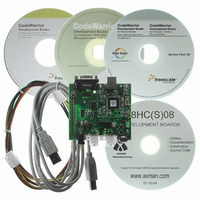DEMO9S08EL32 Freescale Semiconductor, DEMO9S08EL32 Datasheet - Page 126

DEMO9S08EL32
Manufacturer Part Number
DEMO9S08EL32
Description
BOARD DEMO FOR 9S08 EL MCU
Manufacturer
Freescale Semiconductor
Type
MCUr
Datasheets
1.DEMO9S08EL32.pdf
(356 pages)
2.DEMO9S08EL32.pdf
(14 pages)
3.DEMO9S08EL32.pdf
(2 pages)
Specifications of DEMO9S08EL32
Contents
Evaluation Board
Processor To Be Evaluated
MC9S08EL32
Data Bus Width
8 bit
Interface Type
RS-232, USB
Operating Supply Voltage
12 V
Silicon Manufacturer
Freescale
Core Architecture
HCS08
Core Sub-architecture
HCS08
Silicon Core Number
MC9S08
Silicon Family Name
S08EL
Rohs Compliant
Yes
For Use With/related Products
MC9S08EL32
Lead Free Status / RoHS Status
Lead free / RoHS Compliant
- Current page: 126 of 356
- Download datasheet (9Mb)
Internal Clock Source (S08ICSV2)
The CLKS bits can also be changed at anytime, but the RDIV bits must be changed simultaneously so that
the resulting frequency stays in the range of 31.25 kHz to 39.0625 kHz. The actual switch to the newly
selected clock will not occur until after a few full cycles of the new clock. If the newly selected clock is
not available, the previous clock will remain selected.
8.4.3
The BDIV bits can be changed at anytime and the actual switch to the new frequency will occur
immediately.
8.4.4
The low power bit (LP) is provided to allow the FLL to be disabled and thus conserve power when it is
not being used. However, in some applications it may be desirable to enable the FLL and allow it to lock
for maximum accuracy before switching to an FLL engaged mode. Do this by writing the LP bit to 0.
8.4.5
When IRCLKEN is set the internal reference clock signal will be presented as ICSIRCLK, which can be
used as an additional clock source. The ICSIRCLK frequency can be re-targeted by trimming the period
of the internal reference clock. This can be done by writing a new value to the TRIM bits in the ICSTRM
register. Writing a larger value will slow down the ICSIRCLK frequency, and writing a smaller value to
the ICSTRM register will speed up the ICSIRCLK frequency. The TRIM bits will effect the ICSOUT
frequency if the ICS is in FLL engaged internal (FEI), FLL bypassed internal (FBI), or FLL bypassed
internal low power (FBILP) mode. The TRIM and FTRIM value will not be affected by a reset.
Until ICSIRCLK is trimmed, programming low reference divider (RDIV) factors may result in ICSOUT
frequencies that exceed the maximum chip-level frequency and violate the chip-level clock timing
specifications (see the
If IREFSTEN is set and the IRCLKEN bit is written to 1, the internal reference clock will keep running
during stop mode in order to provide a fast recovery upon exiting stop.
All MCU devices are factory programmed with a trim value in a reserved memory location. This value can
be copied to the ICSTRM register during reset initialization. The factory trim value does not include the
FTRIM bit. For finer precision, the user can trim the internal oscillator in the application and set the
FTRIM bit accordingly.
8.4.6
The ICS module can support an external reference clock with frequencies between 31.25 kHz to 5 MHz
in all modes. When the ERCLKEN is set, the external reference clock signal will be presented as
ICSERCLK, which can be used as an additional clock source. When IREFS = 1, the external reference
clock will not be used by the FLL and will only be used as ICSERCLK. In these modes, the frequency can
be equal to the maximum frequency the chip-level timing specifications will support (see the
Overview
126
chapter).
Bus Frequency Divider
Low Power Bit Usage
Internal Reference Clock
Optional External Reference Clock
Device Overview
MC9S08EL32 Series and MC9S08SL16 Series Data Sheet, Rev. 3
chapter).
Freescale Semiconductor
Device
Related parts for DEMO9S08EL32
Image
Part Number
Description
Manufacturer
Datasheet
Request
R
Part Number:
Description:
Manufacturer:
Freescale Semiconductor, Inc
Datasheet:
Part Number:
Description:
Manufacturer:
Freescale Semiconductor, Inc
Datasheet:
Part Number:
Description:
Manufacturer:
Freescale Semiconductor, Inc
Datasheet:
Part Number:
Description:
Manufacturer:
Freescale Semiconductor, Inc
Datasheet:
Part Number:
Description:
Manufacturer:
Freescale Semiconductor, Inc
Datasheet:
Part Number:
Description:
Manufacturer:
Freescale Semiconductor, Inc
Datasheet:
Part Number:
Description:
Manufacturer:
Freescale Semiconductor, Inc
Datasheet:
Part Number:
Description:
Manufacturer:
Freescale Semiconductor, Inc
Datasheet:
Part Number:
Description:
Manufacturer:
Freescale Semiconductor, Inc
Datasheet:
Part Number:
Description:
Manufacturer:
Freescale Semiconductor, Inc
Datasheet:
Part Number:
Description:
Manufacturer:
Freescale Semiconductor, Inc
Datasheet:
Part Number:
Description:
Manufacturer:
Freescale Semiconductor, Inc
Datasheet:
Part Number:
Description:
Manufacturer:
Freescale Semiconductor, Inc
Datasheet:
Part Number:
Description:
Manufacturer:
Freescale Semiconductor, Inc
Datasheet:
Part Number:
Description:
Manufacturer:
Freescale Semiconductor, Inc
Datasheet:










